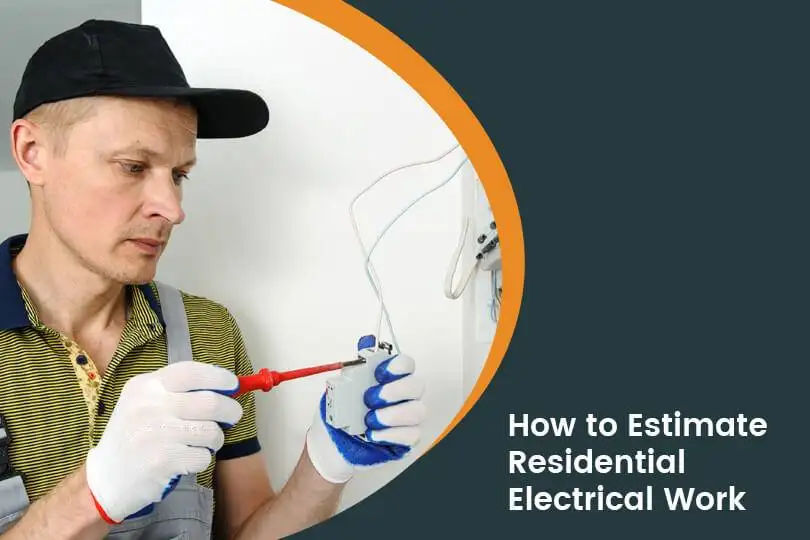How To Estimate Residential Electrical Work: The Complete Guide for Electrical Contractors

The work of an electrical estimator requires a high level of skill and accuracy. But creating an estimate is even more important if you want to stay ahead of the competition.
Clients use your estimate to determine who wins the job or what they can do with the budget they have available. That said, producing an accurate estimate is not an easy task! There are many variables that go into creating an estimate, and on some projects, the estimating task alone is huge. If you want your electrical contractor business to succeed, it is crucial that you learn how to estimate residential electrical work.
Ready to get started with Field Promax?
Sign Up FreeThe electrical contractor industry is both very competitive and highly dynamic. Electricians need to generate new job quotes while strictly adhering to the standard bidding procedure for every new electrical work. Above all else, they need to attempt to achieve that delicate balance between presenting an accurate price that generates sufficient income while also remaining competitive against other bidders on the job.
There’s a lot that goes into determining how to price an electrical service. The estimated price electricians come up with and share with customers must cover all project expenses, from labor and material costs to indirect expenses and earnings, while still being competitive and low enough to outbid other contractors.
Residential electrical work is likely to make up the majority of your sales, whether you’re giving a homeowner an estimate or competing in a bidding process to wire a group of new homes. To build a solid foundation in estimating and executing residential projects, enrolling in an accredited electrical program can equip aspiring electricians with both technical skills and practical knowledge essential for success. As a result, understanding how to estimate household electrical repair is an important skill to have. Although preparing an estimate might be time-consuming, it is important to take your time to ensure accuracy before beginning any electrical repair. Making a mistake in the middle of a project could cost you additional time and money.
So, what can you do to avoid mistakes, or better yet, create flawless estimates that win you the bid every time? Your estimating methodology plays a crucial role in this regard. In case you are unsure about how to estimate residential electrical work accurately and fairly, here is a step-by-step guide for you.
Understanding the Scope of Residential Electrical Work
Understanding the scope of residential electrical work is crucial for electrical contractors to accurately estimate project costs and effectively plan their workflow. The scope encompasses the full range of electrical tasks and installations required to meet the needs of residential properties, including new construction, renovations, and repairs. This may involve wiring installation, electrical panel upgrades, lighting fixtures, outlets, switches, and appliance connections, among other components. Furthermore, understanding the scope involves assessing the complexity and scale of the project, considering factors such as the size of the property, the number of rooms, the level of customization desired by the client, and any specific electrical requirements dictated by local building codes and regulations.
In addition to physical installations, the scope of residential electrical work requires considering the timeline and logistics involved in completing the project. Contractors must account for factors such as the availability of materials and equipment, scheduling constraints, and coordination with other tradespeople and contractors. Moreover, a thorough understanding of the scope enables contractors to identify potential challenges and anticipate any additional work or modifications that may arise during the course of the project.

To accurately estimate the scope of residential electrical work, contractors must conduct a thorough assessment of the property and consult with the homeowner to understand their needs and preferences. This involves conducting a site inspection to evaluate the existing electrical system, identifying any issues or deficiencies, and determining the extent of work required to meet the homeowner’s objectives. Contractors must also consider factors such as the type and quality of materials needed, the labor required to complete the installations, and any additional services such as permitting and inspections. By gathering all necessary information and collaborating closely with the homeowner, contractors can develop comprehensive estimates that outline the scope of work, the associated costs, and the projected timeline for completing the project. By gaining a clear understanding of the scope upfront, electrical contractors can ensure that their estimates are comprehensive and accurate, leading to successful project outcomes and satisfied clients.
Residential Electrical Work: Components and Phases
Embarking on a residential electrical project can be a daunting task, for homeowners and contractors alike. From wiring installations to fixture placements, understanding the components and phases of a residential electrical project is essential for ensuring its success. Let’s break down the key components and phases of a typical residential electrical project to provide clarity and guidance for homeowners and contractors alike.
Understanding the Components:
Wiring Installation: The backbone of any electrical system, wiring installations involve running electrical cables through walls, ceilings, and floors to provide power to various areas of the home.
Electrical Panel Upgrades: Upgrading the electrical panel ensures that it can handle the increased demand for power in modern homes, accommodating additional circuits and appliances.
Fixture Installations: This includes the installation of lighting fixtures, ceiling fans, outlets, switches, and other electrical devices throughout the home.
Appliance Connections: Connecting appliances such as refrigerators, ovens, washers, dryers, and HVAC systems to the electrical system requires careful wiring and installation to ensure proper functionality and safety.
Phases of the Project:
Planning and Design: The initial phase involves assessing the electrical needs of the home, creating a plan, and designing the layout of electrical components and fixtures.
Preparation: Preparing the site involves gathering materials, tools, and equipment needed for the project, as well as obtaining necessary permits and approvals.
Installation: The installation phase includes wiring, fixture installations, appliance connections, and any necessary upgrades or modifications to the electrical system.
Testing and Inspection: Once the installations are complete, thorough testing and inspection ensure that everything is functioning properly and meets safety standards.
Completion and Cleanup: The final phase involves completing any finishing touches, such as securing wires, labeling circuits, and cleaning up the work area, before handing over the project to the homeowner.
How to Create Accurate Estimates for Residential Electrical Work
1. Select Your Projects Carefully
Being a professional electrical contractor, you must avoid saying yes to all your project requests just to make a few bucks. Any reputable electrical business guide will warn you to never accept any project that comes knocking on your door. Instead, be honest with yourself and your clients and refuse to do any assignments where you lack experience or are unable to appropriately estimate prices. Until you have more experience, stick to projects that are within your scope and those you are confident with. Take the time to assess each job’s requirements and inform your customer if you are unable to accomplish them in a timely manner.
To present a precise and reasonable bid, remember that it’s best to stick to the types of jobs that you are confident and competent in. You can gradually tap into new opportunities with the same effectiveness as you gain experience.
2. Be Thorough with Job Assessments
If you’re bidding on anything, make sure you read the parameters in the request for proposal (RFP). A clear understanding of the requirements can ease the electrical estimating process and deliver an accurate and precise electrical estimate. Look for oversights or abnormalities and understand whether the project stands in terms of the current electrical spectrum or not. Before you put the figures solely based on your electrician prices list, figure out what the client’s requirements and expectations are for the electrical component of the job that you are being asked to deliver. Are there any irregularities or mistakes in their scope? What is the client anticipating from you if you are selected as the winning bidder? You need to thoroughly evaluate the project specs to uncover the answers to these queries.
You can’t determine the quality of the work you’re supposed to produce unless the specifications are accurate. Furthermore, without clarity, you may end up underquoting or overestimating, often losing the bid as a result.
Want a personalized demo?
See how Field Promax can transform your field operations
3. Review the Drawings Carefully

As an electrical contractor, you can access blueprints, illustrations, and drawings with the RFPs so you can get a thorough understanding of the electrical requirements. To establish a clear scope of work, carefully examine the available plans and blueprints. Look over the drawings at a high level to get an idea of the full scope of work. You should review the architectural drawings in addition to the electrical drawings to understand working heights and elevations that will affect labor costs, material pricing, and equipment requirements.
All these factors influence the material and labor expenses, as well as the equipment needs, regardless of whether it is a residential or commercial electrician estimate. Your material estimates may be wrong if you overlook any one of these factors, rendering your efforts and estimates useless.
4. Check the Material Costs
Material costs significantly impact the accuracy of your electrical project estimate. You must clearly define the material quantity required to complete the requested job successfully. To this end, begin with the process of counting and measuring items depicted in the electrical drawings, like light fixtures, receptacles, conduit runs, panels, and gear. Start with one item and count all items sheet by sheet, keeping totals per sheet before moving to the next item. If you find something you missed earlier, immediately count it and adjust your previously noted quantity.
This list, also known as a material takeoff list, allows you to produce a material cost breakdown. The detailed description and quantity are necessary to reduce the complexity of the electrical project execution.
5. Calculate the Labor Cost
After completing the material cost breakdown, you should focus on the total labor costs involved in executing the project. You can refer to your local electrician pricing guide to find out the standard rates. But before you do so, make sure you choose a specific pricing model, like fixed or hourly rates, based on the project’s demands. Calculate how many employees are required to finish a task, then add up each of their hourly pay rates to arrive at your total hourly labor rate. Multiply your hourly labor rate by the number of hours you expect the work to take. A simple method to estimate the labor cost is to apply the following formula
Total labor rate = hourly labor rate x number of hours
Keep a window open to add overtime hours, accidental damages, overhead costs, indirect expenses, and other miscellaneous expenses that can add to your labor costs.
6. Factor In Taxes
Different businesses neglect the taxation segment during the cost estimation. Ensure that you add your business taxes to your cost estimation or charge them separately while giving away the invoice. But if you choose to charge the taxes in your quotation, you must calculate the business tax for one job. It can help you increase your cost estimation accuracy and avoid the chances of skipping the tax inclusions in your estimates or invoices.
7. Include Overheads and Profits
If you only compute how much the work will cost you (labor plus material expenses), then you will not profit from the work. In reality, you’ll be losing money since you’re not covering all of your business costs, including transportation and insurance.
Every electrical estimate for a residential project should include overhead expenditures in your budget to account for all of your business’s expenses. Depending on your business expenditures, overhead is approximately 13–20 percent of your overall sales cost.
8. Double-check All Your Figures
Make sure that all the information on the estimate is valid and that nothing has changed since you started the process before giving it over to your customer. Make sure you include the following details:
- Name and address of the customer
- Materials and price list
- Hours and expenses of labor
- Total daily cost
You can redo some of the calculations if required to verify that the final amount you provide your customer is accurate.
9. Create the Estimate
Once you have calculated the labor and material costs, analyzed the taxes for one electrical job, and specified your profits, you can kick-start the estimation process.

A Better Alternative
Does the process sound lengthy and arduous? If your answer is ‘yes’, you are not alone. Objectively, creating estimates is indeed a complex and cumbersome task. Moreover, you need to take the utmost care with every detail and figure at every step. One single mistake and all your hard work will go down the drain. Not to mention, it involves a huge risk of not being able to win the bid. As long as you are doing it manually, you cannot escape this.
But wait, do not lose hope just yet! There is a better and more efficient alternative available for your estimation needs. All you need is an electrical estimation software system. It is essentially a digital tool that helps electrical professionals accurately estimate the labor, materials, and difficulty of each job. These systems typically include databases for thousands of items to make quotes and provide guidance for electrical jobs. By automating the system with this digital tool, you can deftly avoid all risks of miscalculation and overlooked items. Thus, it enables you to come up with flawless estimates every time with just a few clicks on your computer. Moreover, there are now electrical estimator apps available with which you can take care of the task from your smartphone, regardless of where you are.
If you want more value for your money, you have options for that as well. Instead of an estimator, sign up for Field Promax electrical business software. It is a dedicated field service management software that comes with a chock-full of features to automate and streamline your entire business process. But why are we recommending Field Promax? Because it offers the best estimate feature in today’s market.
So why wait? Sign up now.
For more information, contact Field Promax
We're here to help you get started